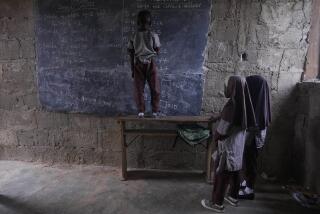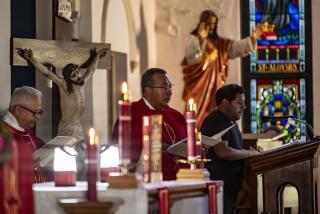U.S. Missteps Leave Iraqis in the Dark
KHOR ZUBAYR, Iraq — When the United States fires up the last generator at this remote power plant this week, it will mark the conclusion of one of the most frustrating episodes in the effort to rebuild Iraq’s infrastructure.
A pile of gray metal swarming with construction workers in the deserts of southern Iraq, the Khor Zubayr generating station is the final power plant being built under Washington’s ill-fated $4-billion attempt to restore Iraq’s electrical supply to its prewar level.
The massive U.S. effort will leave behind this legacy: Iraqis will actually have, on average, fewer hours per day of electricity in their homes than they did before the U.S.-led invasion in March 2003.
“The money was not effective,” Muhsin Shalash, Iraq’s minister of electricity, said in an interview. “The contracting was wrong. The whole planning was wrong.... It’s a big problem.”
U.S. officials have blamed insurgent attacks, unchecked demand and the poor conditions of Iraq’s power plants for hobbling the bid to restore electricity. But interviews with dozens of U.S. and Iraqi officials reveal that poor decisions by the United States also played a significant role.
Perhaps most serious was the decision to expand a program begun under Saddam Hussein to install dozens of natural-gas-fired electrical generators, U.S. and Iraqi officials said. Iraq has such gas in abundance, but it uses only a fraction of it. The rest is burned off during oil production.
The U.S. spent hundreds of millions of dollars to purchase and install natural-gas-fired generators in electricity plants throughout Iraq. But pipelines needed to transport the gas weren’t built because Iraq’s Oil Ministry, with U.S. encouragement, concentrated instead on boosting oil production to bring in hard currency for the nation’s cash-starved economy.
In at least one case, the U.S. paid San Francisco-based Bechtel Corp. $69 million for a natural-gas-fired plant that was never built, according to State Department documents and U.S. officials.
All told, of 26 natural gas turbines installed at seven plants in Iraq -- ranging in cost from a few million dollars to more than $40 million -- only seven are burning natural gas, reconstruction officials said.
Faced with widespread power shortages, the U.S. Army Corps of Engineers and the State Department decided to reconfigure many of the generators to burn a different fuel, an expensive process that decreased generation capacity and increased maintenance.
“You’ve got the wrong technology for the fuel we’re burning, the wrong technology being gas turbines,” said Bill Thompson, generation manager for the Project and Contracting Office, a Defense Department reconstruction agency. “But we’re here and this is what we’ve got.”
In many cases, the fuel in question has been heavy fuel oil, a tarry byproduct of Iraq’s primitive refineries that has wreaked havoc on the natural gas generators. One turbine installed by the U.S. at a cost of $40 million at the Baiji power complex in north-central Iraq already needs replacement.
“My concept as a layman [is that] we basically wrecked the unit” that needs replacing, said Dennis Karns, the Army Corps official heading the power sector.
The U.S. simply canceled other plants. It scrapped the Bechtel project, a planned power station near the Mansuriya fields in northeastern Iraq, because it feared it would take too long to build and cost too much, said officials with the U.S. Agency for International Development.
Although the plant was never built, the U.S. paid Bechtel $69 million for drawing up plans, setting up a construction camp and buying two generators that were later installed elsewhere, USAID officials said. Bechtel also received $160 million to cover security and other unexpected costs in connection with other reconstruction projects.
“Starting about late 2004, we were finding out that security constrained our ability to build all the things we wanted to,” said Heather Layman, a USAID spokeswoman.
A Bechtel official said the money was well spent since it paid for the gas-fired generators now in use elsewhere and provided the Iraqis with plant designs.
“Our position is it was a viable project,” said the official, who asked not to be identified for security reasons.
The decision to rely so heavily on natural-gas-fired generators is a source of great frustration in the current Iraqi government. Shalash, the electricity minister, said the U.S. and the interim Iraqi government shared blame for not better understanding Iraq’s power infrastructure.
“It was a combination of lack of knowledge and ... people who were from the outside who did not have experience,” Shalash said. “All they were doing is signing contracts, buying turbines and not bringing electricity to people.”
Another serious problem was the failure to charge private consumers for electricity, which a U.S. advisor called one of the worst mistakes of the U.S.-led occupation, according to a recent report by the U.S. Institute of Peace, a congressionally funded think tank.
The virtually free power encouraged wealthy and middle-class Iraqis to go on a spending spree after the invasion, buying refrigerators, heaters and other goods.
As a result, demand for electricity surged far past supply. When the U.S. finishes its building program, Iraq will be able to produce about 5,500 megawatts on a sustained basis, about 1,000 more than the country produced under Hussein’s government. But demand has soared to 9,000 megawatts during Iraq’s sweltering summers and chilly winters.
Thus, while the U.S. will have technically reached its goal of restoring Iraq’s power output to prewar levels, the average Iraqi will have about 10 to 12 hours of power a day, less than under Hussein. Those living in urban centers such as Baghdad, Basra and Mosul are especially affected.
Karns, of the Army Corps of Engineers, said it would be “multiple decades” before Iraqi homes had power 24 hours a day.
“In spite of all these problems, we have made a significant impact in keeping the system stable,” Karns said. “They’re in a much better starting position as they continue forward.”
The lack of reliable electricity is one of the chief frustrations of Iraqis. Almost everyone quizzed about the pace of the reconstruction uttered the phrase “maku kahrabaa“-- there’s no electricity.
“Right now, our issue is electricity,” said Raheem Abdul Sadr, a shopkeeper who was selling brightly colored tricycles and backpacks recently in Baghdad’s Sadr City. “We have no issues except electricity.”
His friend shook his head and concurred: “Electricity, electricity, electricity.”
Unexpectedly high costs for security and maintenance and operational problems also have plagued reconstruction.
By last fall, the Army Corps had run out of cash for several projects being funded with Iraqi oil revenue -- money spent in addition to the $4 billion in U.S. funding. They handed the unfinished plants to the Iraqis, hoping they would finish the work.
Instead, the Iraqis did nothing, their own budget hampered by the insurgency, inefficient state spending, oil production shortfalls and persistent corruption, U.S. officials said.
In January, corps officials decided to renew work on dozens of generators that had been abandoned, this time with U.S. money, in a plan called Project Phoenix.
The U.S. eventually paid Fluor-AMEC, a U.S.-British joint venture, $93 million to complete the work and add 700 megawatts of power to Iraq’s grid.
The delays, however, resulted in millions of angry Iraqis having to sweat through the summer.
“We started it much too late,” Thompson said.
Most of the power projects that were completed, U.S. officials said, have been poorly operated by the Iraqis, who before the invasion relied heavily on foreign contractors to run the plants.
By one U.S. estimate, Iraq would have an additional 1,000 megawatts of power if all of its 19 plants, with 142 generators, were run correctly.
To help remedy the problem, USAID sent scores of Iraqi engineers abroad for training as part of a multimillion-dollar effort to create “tiger teams” that would return and train other Iraqis.
Instead, the engineers were dispersed to different plants when they returned and provided very little training, reconstruction officials said.
“We put the tiger teams out there, but we never got anything out of them,” Karns said.
There have been some successes. The larger problems of the power sector don’t seem to have trickled down to the Khor Zubayr plant south of Basra, which will be the last to go online.
Chris Frabott, an Army Corps official, has spent the last several months installing two mammoth generators. If all goes as planned, they will actually use natural gas piped in from a nearby oil field.
The plant was abuzz with work one day last summer. More than 400 Iraqi workers were employed at the site, which sits alone in the middle of flat, barren desert.
When the plant goes online Thursday, it will deliver 500 megawatts of power to Iraq -- about 10% of current capacity. Frabott looked up at one of the generators and patted its side.
“It’s a lot of work,” he said. “A lot of money.”
More to Read
Sign up for Essential California
The most important California stories and recommendations in your inbox every morning.
You may occasionally receive promotional content from the Los Angeles Times.










